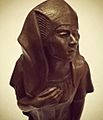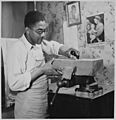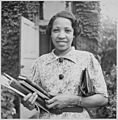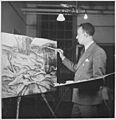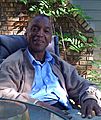African-American art facts for kids
African-American art is a wide term for the visual art created by Black people in the United States. This art is shaped by many cultures, including those from Africa, Europe, and the Americas. Traditional African-American art includes many types of visual creations, from basket weaving and pottery to quilting, woodcarving, and painting.
Contents
History of African-American Art
Early Art: Before and During the Civil War
The first signs of African-American art in the United States come from skilled enslaved craftspeople in New England. These early works include items made for personal use by enslaved people and items made for public use. From the 1600s to the early 1800s, examples include small drums, quilts, iron figures, baskets, ceramic pots, and gravestones.
Many enslaved artisans were very skilled. Their owners often hired them out for work. Sometimes, these enslaved artists could keep a small part of their earnings. This allowed some to save enough money to buy their own freedom and the freedom of their families.
The public artworks made by enslaved craftspeople were very important to the economy in colonial times. In New England and the Mid-Atlantic colonies, enslaved people learned trades like goldsmithing, cabinetmaking, engraving, carving, portrait painting, carpentry, masonry, and iron work. For example, African Americans built and decorated the Janson House on the Hudson River in 1712. Many of the oldest buildings in Louisiana, South Carolina, and Georgia were also built by enslaved craftspeople.
In the mid-1700s, John Bush was an enslaved soldier who carved powder horns. He fought with the British in the French and Indian War.
Some of the earliest known portrait artists were Patrick H. Reason, Joshua Johnson, and Scipio Moorhead, working between 1773 and 1887. Some white families, often abolitionists (people who wanted to end slavery), helped these artists get private lessons. Artists found more support and could earn a living better in cities, especially in the North and border states.
Harriet Powers (1837–1910) was an African-American folk artist and quilt maker from rural Georgia. She was born into slavery. Today, she is famous for her quilts. She used traditional appliqué (sewing fabric pieces onto a larger piece) to show local stories, Bible tales, and events in the sky on her quilts. Only two of her quilts are still around: Bible Quilt 1886 and Bible Quilt 1898. Her quilts are seen as some of the best examples of Southern quilting from the 1800s.
Like Harriet Powers, the women of Gee's Bend developed a special, strong, and detailed quilting style. It was based on traditional American quilts but had a simple, geometric look. Even though they lived far apart, their quilts remind people of Amish quilts and modern art. The women of Gee's Bend passed their skills and style down through at least six generations. Some scholars once thought enslaved people used quilt patterns to share escape plans for the Underground Railroad, but most historians now disagree with this idea. Quilting is still an important art form in the African-American community today.
After the Civil War
After the Civil War, it became more common for art by African Americans to be shown in museums. Artists began creating works specifically for these displays. Most of these works followed European styles, showing landscapes and portraits. The most famous artists from this time include Edward Mitchell Bannister, Henry Ossawa Tanner, and Edmonia Lewis. Other notable artists were Grafton Tyler Brown, Nelson A. Primus, and Meta Vaux Warrick Fuller.
It was easier for African-American artists to gain wide recognition in big American cities like Philadelphia, Boston, Chicago, New York, and New Orleans. However, even in these cities, there were still discriminatory limits. Artists found a much better welcome abroad, especially in Paris, France. In Europe, these artists could experiment more freely and learn new techniques beyond traditional Western art. This freedom of expression was strongest in Paris, and also present in Munich and Rome.
The Harlem Renaissance to Today
The Harlem Renaissance was one of the most important movements in African-American art. During the 1920s, new ideas and freedoms, already common in many parts of the world, began to spread among artists in the United States. Key artists from this period include Richmond Barthé, Aaron Douglas, Lawrence Harris, Palmer Hayden, William H. Johnson, Sargent Johnson, John T. Biggers, Earle Wilton Richardson, Malvin Gray Johnson, Archibald Motley, Augusta Savage, Hale Woodruff, and photographer James Van Der Zee.
The Harmon Foundation, started by William E. Harmon in 1922, supported many artists through its Harmon Award and yearly exhibitions. The Great Depression in 1929 greatly reduced funding for the arts. While the Harmon Foundation continued to exist, its direct financial support for artists ended. However, it still helped artists like Jacob Lawrence by organizing exhibitions until 1967.
In 1933, the US Treasury Department tried to support artists with the Public Works of Art Project, but it wasn't very effective. In 1935, President Franklin D. Roosevelt created the Works Progress Administration (WPA). The WPA helped all American artists, and it was especially useful for African-American artists. Artists and writers, including Jacob Lawrence and Richard Wright, found work that helped them survive the Depression. Art began to explore politics, human conditions, and social issues.
Important cities with large Black populations and active African-American art scenes included Philadelphia, Boston, San Francisco, and Washington, D.C.. The WPA also led to many new Black art professors. Mixed media, abstract art, cubism, and social realism became popular. In 1935, WPA artists formed the Harlem Artists Guild, which created community art centers in major cities. Popular art forms included drawing, sculpture, printmaking, painting, pottery, quilting, weaving, and photography. By 1939, the WPA and its projects ended due to high costs.
In 1943, James A. Porter, an art professor at Howard University, wrote the first major book on African-American art and artists, called Modern Negro Art.
Mid-20th Century Art
In the 1950s and 1960s, few African-American artists were widely known. Despite this, The Highwaymen, a group of 26 African-American artists from Fort Pierce, Florida, created beautiful, quick paintings of the Florida landscape. They sold about 200,000 of these paintings from the trunks of their cars. In the 1950s and 1960s, no galleries were interested in selling art by unknown, self-taught African Americans. So, they sold their art directly to people. They were rediscovered in the mid-1990s and are now seen as an important part of American folk history.
Today, an original Highwaymen painting can sell for thousands of dollars. In 2004, the original 26 Highwaymen were added to the Florida Artists Hall of Fame.
After World War II, some artists took a global approach. They worked and showed their art abroad, especially in Paris. Later, they moved to other welcoming cities like Copenhagen, Amsterdam, and Stockholm. These artists included Barbara Chase-Riboud, Edward Clark, Harvey Cropper, Beauford Delaney, Herbert Gentry, Bill Hutson, Clifford Jackson, Sam Middleton, Larry Potter, Haywood Bill Rivers, Merton Simpson, and Walter Williams.
By the 1950s and 1960s, some African-American artists did get into important New York galleries. These included Horace Pippin, Romare Bearden, Jacob Lawrence, William T. Williams, Norman Lewis, Thomas Sills, and Sam Gilliam. The Civil Rights Movement of the 1960s and 1970s inspired artists to show the changes happening in society. New galleries and community art centers opened to display African-American art. Colleges also created teaching jobs for African-American artists. Some African-American women were active in the feminist art movement in the 1970s. Faith Ringgold created art about Black women and how racism and sexism affected them. The group Where We At (WWA) held exhibitions only for African-American women artists.
By the 1980s and 1990s, hip-hop graffiti became very popular in cities. Most major cities had museums dedicated to African-American artists. The National Endowment for the Arts provided more and more support for these artists.
Kara Walker, a modern American artist, is known for exploring race, gender, violence, and identity in her art. Walker's silhouette images connect old stories from the Antebellum South and remind people of Harriet Powers' earlier work. Her dream-like but imaginative images have a cinematic feel. In 2007, Time Magazine named Walker one of the "100 Most Influential People in The World, Artists and Entertainers."
Textile artists are also a big part of African-American art history. According to a 2010 survey, there are 1.6 million quilters in the United States. Women of Visions, Inc., a non-profit group in Pittsburgh, Pennsylvania, has many members who are quilters and fiber artists. Their artists work in many different materials. Those who have shown their art internationally include Renee Stout and Tina Williams Brewer.
Many influential contemporary artists include Larry D. Alexander, Laylah Ali, Amalia Amaki, Emma Amos, Jean-Michel Basquiat, Dawoud Bey, Camille Billops, Mark Bradford, Edward Clark, Willie Cole, Robert Colescott, Louis Delsarte, David Driskell, Leonardo Drew, Mel Edwards, Ricardo Francis, Charles Gaines, Ellen Gallagher, Herbert Gentry, Sam Gilliam, David Hammons, Jerry Harris, Joseph Holston, Richard Hunt, Martha Jackson-Jarvis, Katie S. Mallory, M. Scott Johnson, Rashid Johnson, Joe Lewis, Glenn Ligon, James Little, Edward L. Loper, Sr., Alvin D. Loving, Kerry James Marshall, Eugene J. Martin, Richard Mayhew, Sam Middleton, Howard McCalebb, Charles McGill, Thaddeus Mosley, Sana Musasama, Senga Nengudi, Joe Overstreet, Martin Puryear, Adrian Piper, Howardena Pindell, Faith Ringgold, Gale Fulton Ross, Alison Saar, Betye Saar, John Solomon Sandridge, Raymond Saunders, John T. Scott, Joyce Scott, Gary Simmons, Lorna Simpson, Renee Stout, Kara Walker, Carrie Mae Weems, Stanley Whitney, William T. Williams, Jack Whitten, Fred Wilson, Richard Wyatt, Jr., Richard Yarde, Purvis Young, Kehinde Wiley, Mickalene Thomas, Barkley Hendricks, Jeff Sonhouse, William Walker, Ellsworth Ausby, Che Baraka, Emmett Wigglesworth, Otto Neals, Dindga McCannon, Terry Dixon (artist), and Frederick J. Brown.
Hip hop is also an important art form for African Americans.
Collections of African-American Art
Many American museums have works by African-American artists, including the Smithsonian American Art Museum. Colleges and universities with important collections include Fisk University, Spelman College, and Howard University. Other notable collections of African-American art are the Walter O. Evans Collection of African American Art, the Paul R. Jones collections at the University of Delaware and University of Alabama, the David C. Driskell Art collection, the Harmon and Harriet Kelley Collection of African American Art, the Schomburg Center for Research in Black Culture, and the Mott-Warsh collection.
Images for kids
-
Harriet Powers, Bible quilt, Mixed Media. 1898.
-
Painter, sculptor, illustrator and muralist Charles Alston in 1939.
-
Sculptor, printer, and conceptual and visual artist Willie Cole in 2004.
-
Conceptual post-black artist Rashid Johnson in 2015.










